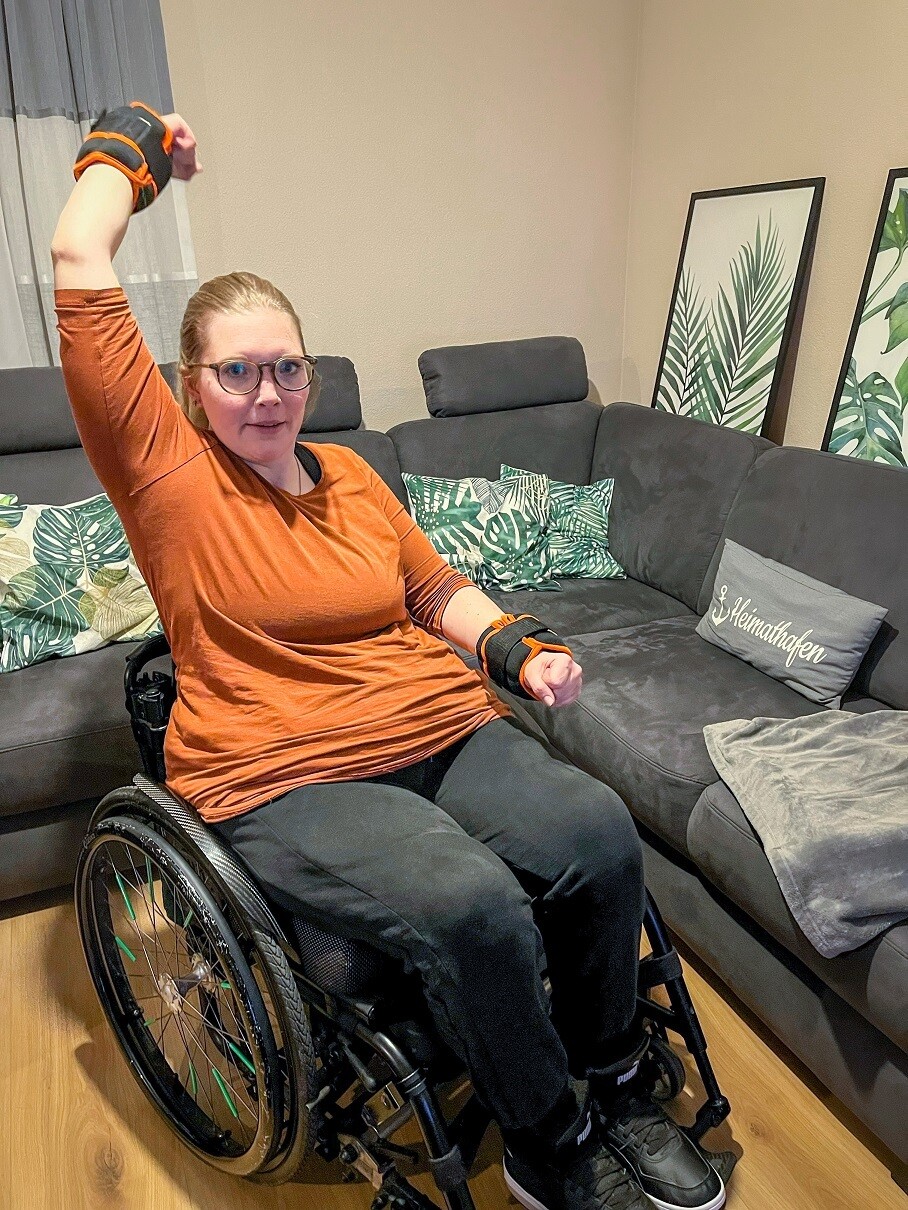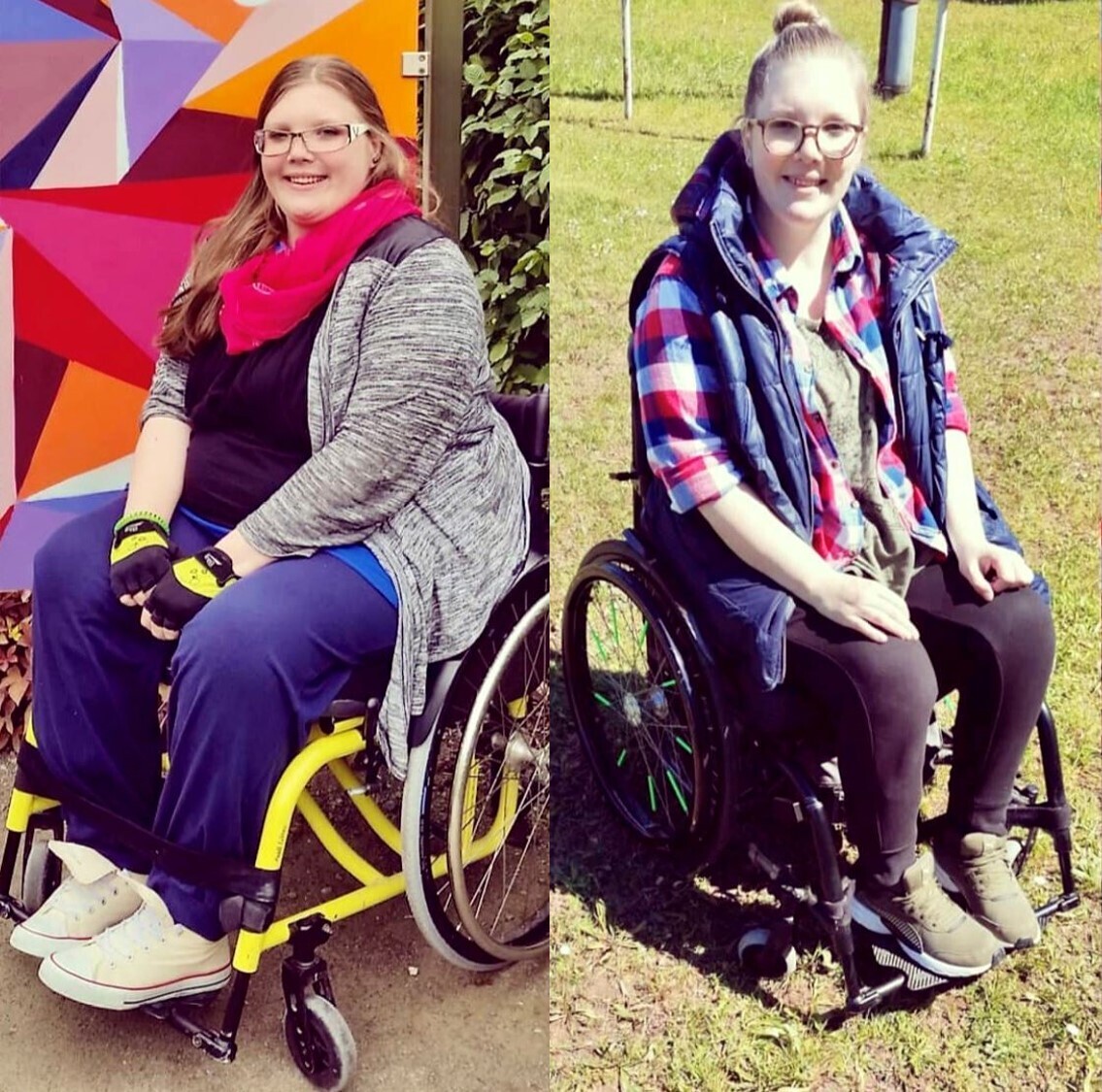Daisy explains how she has managed to lose over 60 kilos in a wheelchair
- 6 minutes to read
- 12 January 2023
- Sima Pöschel
Daisy explains how she has managed to lose over 60 kilos in a wheelchair
Due to the illness, Daisy has gained 100 kilos
Daisy is 30 years old and trained as a domestic services manager. She lives in a small town in the northern Black Forest together with her partner. Before she became ill, she managed her parents’ restaurant with lots of vigor and joy.
When Daisy was diagnosed with systemic lupus erythematosus (SLE) ten years ago, a lot changed for her. The auto-immune disease attacked her nervous system; as a result she suffered from meningitis and encephalitis. It continued to develop and caused and inflammation of the spinal cord which led to lasting damage of the nerves. Since then Daisy is paraplegic and is fighting her way back into life. However, she is not yet ready to take on a new job.
The cortisone therapy with all its side effects – water retention and increased craving for food – as well as the long hospital stay lead to a strong weight increase: approximately 100 kilos. “I rose like a plaited loaf”, she said about herself.
This needed to change, she understood immediately. With the right diet and exercise she successfully started to fight the excess kilos. Which hurdles she had to overcome and what helped her the most she explained to the Community in an interview.

Labrador boy Leo keeps Daisy going and even helps her losing weight.
Finding the right exercises
While her new partner supported Daisy in her endeavors, the setting did not make things easier for her. In the northern Black Forest the range of sports for wheelchair users is limited or not available at all. At the gym, most devices were not usable as the seats were installed permanently or there were no back rests. And also the internet did not provide a lot of information. The only remaining option was to start her own training program at home.
Together with her physio therapist, Daisy established a training plan with exercises that she was able to accomplish. It was important to estimate exactly what her body would be able to handle. How stable is the rump and mobility of the arms for balancing? Due to the different levels of paralysis, there were exercises which Daisy was able to accomplish without problems on the right side but which were challenging on the left. This meant she could not simply follow along the classical exercises for the upper body in videos and do them in a sitting position.
It cost Daisy time and perseverance to find alternative solutions. She is glad to have a capable and ambitious physio therapist. Most physios are not trained in treating patients with spinal cord injury, explains Daisy, and neither is her therapist. However, she did a lot of reading about the topic to be able to better support Daisy.
The illness does not allow for sticking to the training plan
Daisy trains using a Thera Band and weights. But she does not use the normal weights. Due to cramps, especially in her hands, it happens that she drops the weights or cannot let go of them. That’s why she uses weight bands. “One dent in the floor is enough!” she laughs. She learned the trick at rehab when she trained together with a quadriplegic.

Due to the weight bands, Daisy is not afraid of the weights slipping out of her hand.
But Daisy’s preferred – and therefore most effective – workout is the handbike. It is not only sporty but also makes her more mobile and is easy to integrate into daily life. She uses the model Speedy Versatio F; it also offers motorized support which she can adjust as needed on several levels. Because she enjoys it so much, she uses it very often.
By her side is her three-year-old four-legged friend Leo: A male Labrador who keeps her going and with whom she is currently training to make him a companion dog.
Daisy also mentions wheelchair Zumba which was offered online during COVID times and which she enjoyed a lot. However, it is not offered any more and no similar offers are available either. There are, on the other hand, countless training videos available for persons without disabilities, she says.
Daisy is not able to stick to a strict training plan. She has to adapt her training to her physical condition which is influenced by the illness.

Because Daisy enjoys using her handbike so much, she uses it frequently.
The right diet and the correct drinking patterns
Aside from the training, the diet is an important factor. Daisy explains that the diet played a key role in her weight loss. She emphasizes one point: the proper drinking pattern. A large amount of liquid, especially plain water, helps with weight loss. This is suggested by studies. The body can easily confuse the feeling of thirst with feeling hungry why one may eat more than necessary.
Drinking enough, preferably before becoming thirsty, can prevent this. Furthermore half a liter of water before every meal stimulates the energy metabolism.
It is important to drink water or unsweetened teas, to avoid unnecessary calories. When changing her diet, Daisy noticed that not every water tastes the same. She now buys water that is a little more expensive which she likes better.
She learned about nutrition herself. Also her vocational training included the topic of nutrition in which she was very interested already back then. After becoming ill, she bought specific books about nutrition and spinal paralysis or diet and SLE. She thus learned which foods are more difficult to digest for wheelchair users and which ones may have a positive effect on her illness.
This is what she uses as a guide but it’s an up and down, she admits. Also her mental state plays a role. Based on her own experience, she recommends to others to not forgo everything that is “not good”. Also small treats and snacks should be a part. Too much sacrifice can lead to ravenous appetite and stress, which is counterproductive.
Bee venom therapy
Another decisive aspect for Daisy was to discontinue using medication that contains cortisone and the end of its associated side effects. Daisy achieved this by doing a bee venom therapy: She let herself sting by bees regularly. The complex mix of the venom leads to a local inflammation in healthy tissue; in inflamed tissue, however, it has an anti-inflammatory effect as the venom contains apamin and melittin which stimulate the body’s own cortisone production and thus inhibit the exuberant immune reaction. Since the therapy, Daisy’s CRP value – C-reactive protein which counts as a reliable inflammation parameter – has dropped considerably. She was therefore no longer dependent on cortisone to reduce the value.
Caution: The bee venom therapy has not yet been sufficiently studied and its effectiveness is not scientifically proven. The effects described here are exclusively based on personal experience. As any therapy, also this one contains risks. Before considering this therapy, inform yourself sufficiently and, in any case, take an allergy test.
Support from a coach
At a certain point, Daisy was not able to continue on her own. Her successes stagnated. She got in touch with a dietician and training coach who calculated her calorie requirements and determined a personal nutrition plan. Also her coach has not had any experience with clients with spinal paralysis but tries to learn.
Daisy’s weight confirms that her nutrition plan works. Between January and August 2022, she lost 20.5 kilos. Now she only needs to lose another 10 kilos to meet her target weight of 85 kilos.

Daisy in 2014 (left) and in 2020 (right).
Relevant are not only the kilos lost but also the volume measurements, i.e. the circumference. Daisy measures her abdominal circumference as it is much more indicative than the weight shown on the scale. The weight is unreliable as it can fluctuate. Furthermore more weight does not necessarily mean more fat pads as during training muscle mass is built up which is considerably heavier. It can be demotivating if the weight stagnates because muscle building and lost fat are balanced.
On her Instagram profile @daisy_wheelchair, Daisy shares her experiences about the topics of weight loss, nutrition, her illness and life in a wheelchair. She wants to offer the inspiration she had looked for in vain back then to others.
“I want to show that anything is possible. You must believe in it and defeat your lack of willpower. And you need to stay on it because two days of training do not yet result in a great shape.”
Daisy
What are your recommendations on the topic of weight loss? Please share with us!

